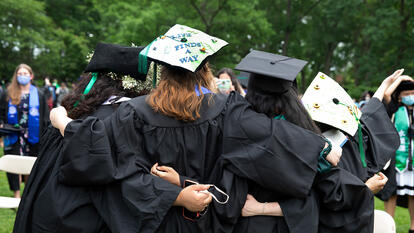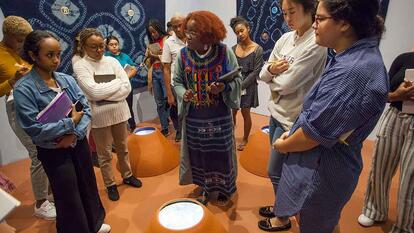Wellesley Faculty Members Use Drones to Enhance Learning

In simulated rescue mission carried out recently during the class Intersections of Technology, Social Justice, and Conflict, a group of Wellesley students relayed directions with hand signals and walkie-talkies to a drone pilot with a control console who was stationed on a small hill near the Keohane Sports Center. The goal of this exercise was for the students to direct the craft to a designated landing zone.
It wasn’t an easy task. Communication and coordination between the students and also Jordan Tynes, manager of scholarly innovations at Wellesley, who piloted the drone, was a challenge, particularly since they had limited time to complete the mission. But they managed to pull it off. The drone dropped its payload and flew back to its base.
Through this exercise, the students learned firsthand the coordination and teamwork required to complete complicated assignments using an unfamiliar technology under trying circumstances, said Amy Banzaert, lecturer in engineering and director of engineering studies. She co-teaches the class with Catia Confortini, associate professor and co-director of peace and justice studies. “One goal is to encourage the students to think critically about limitations of technology that is touted as a problem-solving innovation,” Banzaert said. (This is Banzaert and Confortini’s first semester teaching the class.)
Confortini said the exercise also exposed students to “the pressure of decision making and dilemmas that may arise when drones are used for disaster relief and humanitarian emergencies, as well as in military operations.”
Increasingly, Wellesley faculty members are turning to unmanned aircraft systems, known as drones, for academic and research purposes, devising innovative ways to deploy the technology to enhance learning.
Tynes, who holds a license from the Federal Aviation Administration to fly drones, has met with a number of faculty members who are interested in incorporating drones in their courses. “It starts with a consultation where I get a picture of what their goals are and what they are already doing, and we discuss what a drone application can add to the subject matter,” said Tynes. “Working together, we get very creative and innovative. Drones are functional and present opportunities for many uses in higher education.”
For faculty unfamiliar with the potential of drones, Tynes gives presentations throughout the school year, and he said his office door is always open to inquiries and questions from interested faculty. He also helps faculty stage the exercises.
Daniel J. Brabander, Frost Professor in Environmental Science, found the drones to be useful in his course Earth Processes and the Environment. He and his students stood on the banks of Paramecium Pond while a drone circled 80 feet above them. As Tynes flew the craft, he activated its camera, which took aerial photographs of the pond and its surrounding landscape that will be used for a class research project the students will complete at the end of the semester.
“It’s not the novelty of drones so much as it is how they can be applied in an academic setting to expand the breadth of our research and teaching,” said Brabander. “It creates a powerful, positive effect on the teaching and learning experience by allowing systems-level analysis.”
Student Charli Klein ’19 watched the drone in action and later talked about its value in helping her and her classmates collect environmental information about the pond.
“[The drone] gave us a vantage point we don’t have from ground level,” she said. “From images taken at that altitude, we’re able to see clearly the totality of the area’s ecosystem and observe the influence of the water flow from the Silver Thread, which flows into Paramecium Pond. It’s much better to see these things from the sky.”



